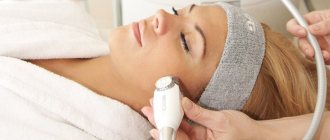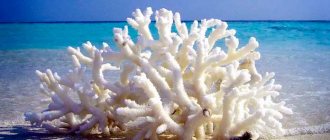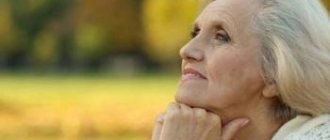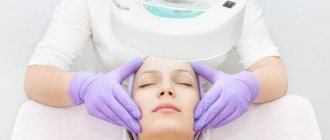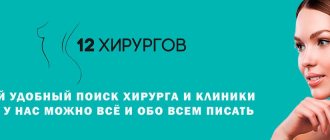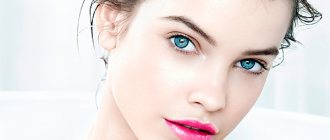Laser resurfacing of the facial skin, the second name of which is laser peeling, is a cosmetic procedure during which dead epithelial cells are removed using laser equipment. Also, during the procedure, you can get rid of various skin defects, such as fine wrinkles, age spots, post-acne, dark circles under the eyes, enlarged pores, unaesthetic moles, scars from chickenpox and tattooing. Laser therapy allows you to get rid of marks that remain on the skin from acne, as well as scars on the face. After laser resurfacing, active restoration of skin cells is observed.
At this stage of development of cosmetology, the technique is considered the safest and quite effective way of rejuvenation and correction of various skin defects.
Preparation for the procedure
To maximize the effectiveness of facial skin resurfacing, you should undergo simple preparation before the procedure, which is prescribed on an individual basis:
- broad-spectrum antibiotics (Azitsin, Sumamed);
- antiviral drug (Famciclovir);
- daily care creams with retinol and glycolic acid, which are prescribed about a month before the procedure. These products reduce the thickness of the top layer of skin, which will allow the laser beam to more easily penetrate the dermis.
The essence of the procedure
The laser beam is actively absorbed by the very thin surface layer of the dermis and transfers a huge amount of energy to the tissue in the shortest period of time. As a result, a microexplosion and evaporation of the tissue that received laser energy occurs. The adjacent layers of skin do not have time to heat up and no burn occurs.
After the evaporation of old cells, active regeneration and renewal of the dermis begins. Fine wrinkles are eliminated by improving blood circulation, destroying fibrous fibers and forming new elastic fibers. The resistance of the dermis to damage also increases.
Two types of laser are used for the procedure: erbium and carbon dioxide. The choice of laser depends on the indication for the procedure; both types are often combined in the same patient. As for efficiency, carbon dioxide laser removes scars and fine wrinkles better, but requires longer rehabilitation (up to 14 days).
Carbon dioxide laser (CO2)
Its penetration depth is up to 20 microns. As a result of radiation, cell ablation (i.e., their rejection due to exposure to temperature) and coagulation (coagulation of peptide compounds) occurs in tissues. This allows you to improve skin tone and texture. After all, protein molecules that have undergone destruction become denser, and the processes of regeneration and replacement of damaged fibers with new ones are launched in the skin.
Carbon dioxide laser, due to its deep penetration and dual effect, provides the highest performance in skin renewal.
Sequence of procedure
- An anesthetic cream is applied to the area of the face that will be exposed;
- The laser attachment is selected individually, depending on the size of the treatment surface.
- The skin is treated with a laser for 5-30 minutes, during which the stratum corneum is removed and young cells are not damaged;
- An ointment with dexpanthenol is applied to the treated skin, which accelerates healing;
Immediately after laser resurfacing, the skin turns red, which is normal. There is also slight swelling. Both symptoms gradually disappear in about 4-5 days.
Skin healing lasts 4-6 days after an erbium laser and 10-14 days after a carbon dioxide laser. In areas of laser exposure, the skin becomes covered with crusts (dead areas), which should fall off on their own. If they are removed forcibly, scars will form. Wound healing ointments with decpanthenol are prescribed, which must be used independently for 10-15 days.
On average, the recovery period is 5-15 days. During this time you cannot:
- use cosmetics;
- be in the open sun (otherwise unsightly pigmentation will form).
Direct sunlight should be avoided for 3 months after the procedure. Also be sure to use sunscreen during this time.
Who is it shown to, what problems does it solve?
Laser facial resurfacing is performed for patients with problem skin. There is no age limit.
The therapy helps eliminate enlarged pores, vascular formations, and increased fat content. Sanding is also used to remove or lighten pigmentation, including raised ones.
The technique copes well with facial wrinkles, sagging skin, residual acne, and blackheads. You can remove shallow scars and scars.
The effectiveness of the procedure depends on the severity of skin changes. Therapy does not remove deep scars, scar formations and wrinkles. It only smoothes them out and makes them less noticeable.
Laser treatment zones
Laser treatment is applied to problem areas. Laser irradiation can be applied to areas of pigmentation, scars, cicatrices, and wrinkles. If the entire area of the face is changed, the treatment area is increased, and continuous grinding is done. They try not to touch the eye and lip area so as not to cause pigmentation, inflammation and other complications.
It's not just the face that can be treated. It is allowed to polish the neck and décolleté.
The difference between laser resurfacing and fractional photothermolysis and peeling
Photothermolysis refers to the technique of exposing the skin to high temperatures and light waves, due to which tissue “evaporates”. This variety includes:
- laser peeling;
- laser resurfacing;
- removal of tumors with a laser beam (fractional laser facial resurfacing).
The most gentle method is laser peeling. It affects the surface layer of the skin and is indicated for minimal problems: acne, fine wrinkles.
Resurfacing is a more aggressive procedure. More often, deep grinding is done, which allows you to remove pigmentation and facial wrinkles. Laser resurfacing of acne is actively carried out. The depth of impact is selected by the cosmetologist depending on the severity of the changes.
Fractional resurfacing is a local laser treatment method. Scars, stretch marks, cicatrices are treated. Laser scar resurfacing is done for both small and deep defects. With deep scars and scars, traces remain. Laser resurfacing of stretch marks is also performed. After therapy they become less noticeable or disappear completely.
All methods are good. The choice of therapy is made only by a cosmetologist, depending on the condition of the facial skin.
Contraindications
Facial resurfacing is an aggressive technique. It provokes complications, so it has many restrictions. The list of contraindications includes:
- diabetes;
- epilepsy;
- oncopathology;
- tuberculosis;
- pathologies of blood clotting ability;
- heart and vascular diseases, wearing an artificial pacemaker;
- herpetic rashes;
- period of gestation and breastfeeding;
- infectious diseases;
- wounds, scratches, burns on the skin;
- disturbance of melanin metabolism;
- autoimmune diseases;
- psoriasis;
- use of retinoid drugs;
- tendency to the appearance of keloid scars;
- heat.
Therapy is not done during menstruation, as pain sensitivity increases. It is optimal to carry out resurfacing 3-4 days before ovulation.
Preparation for therapy
In order for the procedure to be completed safely, preparation must be carried out. There is a list of events:
- do superficial peeling 7 days before polishing;
- prescribe a course of antiviral therapy;
- within 7 days, stop using drugs that affect blood clotting, antibiotics, hormonal substances, retinoids and herbal preparations;
- exclude alcoholic beverages, visits to the bathhouse, solarium, sauna, gym 14 days before therapy.
Therapy is not carried out in summer and spring. This increases the risk of complications due to excessive exposure to sunlight, wind and other factors.
Rules for therapy
Laser rejuvenation is performed in medical plastic surgery centers (hospitals) and qualified salons. Laser resurfacing must be performed by a trained cosmetologist or plastic surgeon. The duration of the procedure is 30-90 minutes depending on the area being treated.
For resurfacing, local or general anesthesia is used, as the procedure is painful. The following stages of therapy are distinguished:
- 1The patient is placed on the couch, the face is treated with an antiseptic;
- 2An anesthetic gel is applied or anesthesia is given depending on the type of resurfacing (deep, superficial). The local anesthetic takes effect within 30 minutes;
- 3The facial skin is treated with a laser device. Possible tingling, pinching, and sometimes severe burning;
- 4After completing the technique, apply a product with dexpanthenol (healing substance).
After therapy, they are sent home or left in the hospital for several days.
Recovery period
Laser resurfacing of facial skin is a traumatic procedure, so the rehabilitation period is 2 weeks or more. Complete healing of the skin is observed after 30 days. Symptoms after therapy:
- 1Severe redness, discharge of serous fluid, the appearance of brown spots on areas of pigmentation, the appearance of small dots at an equal distance from each other. Redness persists for up to 1 month;
- 2From day 2, swelling of the face increases, the volume of the cheeks and chin increases; symptoms persist for up to 4 days;
- 3In the first week, crusts appear.
To prevent complications, rehabilitation measures are carried out. After laser therapy, you need to buy sterile bandages, a cold pack, painkillers, antibacterial drugs, moisturizing and healing ointments, creams. Care and recovery products are prescribed by the doctor. Activities during recovery:
— Do not scratch or damage the skin with washcloths, scrubs, or acids. — Apply bandages, change 5 times a day, do not wash. It is allowed to use thermal water, which is sprayed on the face. - Apply a cold compress. It relieves inflammation and swelling, and anesthetizes the laser treatment site. Apply ice (through a towel) or a cold pack. Apply the compress for 20 minutes, including before bedtime, as the swelling increases when lying down. — To soften the crusts, use a vinegar solution (a glass of water, 10 ml of vinegar). Sterile wipes are used for the compress. As the compress warms up, it is changed. - Compresses are applied after bleeding has stopped. — Use moisturizing serums and creams for dry skin. If there is increased fat content, Vaseline is suitable. — You need to sleep on a high pillow so that the swelling does not increase.
After a week, it is allowed to use cosmetics and decorative cosmetics, but only in the absence of allergies and inflammation. It is recommended to use anti-inflammatory and antiseptic creams. Before going outside, apply cream with an ultraviolet filter and put on a hat with a brim.
After 2-3 weeks the skin heals. Be sure to use a moisturizer and emulsion with an SPF factor. During the entire recovery period, you cannot go to the bathhouse, solarium, sauna, or gym. It is not advisable to eat salty foods or drink alcohol. This will cause swelling. If the rules of care are violated, the following complications are possible:
- erythema (severe redness, inflammation); - pronounced pigmentation; — infection; - scar formations.
If such symptoms appear, you must immediately come to a cosmetologist for an appointment.
Is it possible to shorten rehabilitation?
The duration of rehabilitation is from 2 to 4 weeks. The recovery period can be shortened by following all the doctor’s recommendations. It will be effective to properly prepare for the procedure, choose a qualified cosmetologist or doctor who has extensive experience in resurfacing.
How to choose a safe technology
To choose a technology, you need to contact a cosmetologist. He will examine your facial skin for problems. The doctor will collect anamnesis and rule out contraindications. Depending on the severity of skin defects, types of lasers are chosen:
Carbodioxide . Impact depth up to 20 microns; Cells are removed under the influence of temperature, protein compounds coagulate. The method improves skin texture and elasticity, stimulates tissue regeneration. This type of therapy is most effective in facial rejuvenation.
Erbium . Acts at a shallow depth - 1 micron. The doctor can adjust the depth of radiation. The main action is ablation or removal of cells. Cells are evaporated very quickly, so neighboring areas are not affected. Erbium laser resurfacing is called “cold”.
Low intensity . The impact is carried out by low-intensity, low-frequency light beams. This technique is the most gentle and is not suitable for serious defects.
The choice of laser is made only by a cosmetologist.
How to protect yourself from possible mistakes and complications
Laser resurfacing should be carried out after consultation with a cosmetologist, dermatologist, or therapist. Doctors will rule out possible contraindications, select appropriate therapy, type of laser, and discontinue medications in a timely manner. A trained cosmetologist is selected to perform the procedure. A plastic surgeon would be ideal.
Before carrying out therapy, a service agreement is drawn up, which specifies all types of complications and a protocol. Be sure to read the document. You cannot do the procedure at home or in private cheap salons.
After therapy, it is advisable to stay in the hospital for rehabilitation measures for 2-3 days. This will prevent infection of the skin and severe swelling.
Positive results after therapy
If the rehabilitation period went well, then after 2-3 weeks you can evaluate the result of the procedure. Sanding effects:
- 1Smoothing the surface of the skin, reducing the depth of wrinkles, scars, removing irregularities that arise with age;
- 2Increasing turgor and elasticity of the dermis;
- 3Improving appearance, evening out tone, disappearance or fading of pigmentation.
The first improvements are noticeable after 10 days.
Number of sessions
The average number of procedures per course is 3-7. It is possible to reduce or increase the number of sessions depending on the effect and severity of the defects.
After deep facial resurfacing, a break of 6-8 months is taken, after which a repeat visit is scheduled.
What sensations arise during therapy?
Facial resurfacing is performed under local anesthesia. There is no pain when using the anesthetic. If deep resurfacing is performed, general anesthesia is given.
During the session, tingling, tingling, burning is possible. If pain appeared, the specialist used a low-quality anesthetic. Pain is also possible with increased sensitivity of the skin.
Cons of the procedure
The main disadvantage of resurfacing is its low effectiveness on deep wrinkles and scars. Also the disadvantages include:
- 1Long rehabilitation period - 2-4 weeks;
- 2Pain, severe redness, swelling, itching after therapy;
- 3High cost;
- 4Inability to conduct a session at home;
- 5Risk of stains and burns.
Before choosing resurfacing, you must consider all the disadvantages of the procedure.
What time of year should I do it?
Laser therapy is very traumatic, so summer and spring should be avoided. The procedure is carried out in autumn and winter. This prevents the exposure of damaged skin to ultraviolet radiation, wind and other factors.
Laser facial resurfacing is effective for patients with any skin. It can be done for medium and small expression wrinkles and shallow scars. The technique allows you to remove pigment spots and increase skin turgor. To carry out the procedure, you need to consult a cosmetologist and choose a high-quality clinic. To prevent complications, strict adherence to the cosmetologist’s care recommendations is required.
Positive effects and benefits of laser peeling
- Visible narrowing of pores, smoothing of fine wrinkles;
- Significant reduction in the size of large skin defects;
- Stimulation of collagen formation, due to which the restored skin becomes more elastic and smooth;
- Activation of cellular metabolism - new cells are formed more actively, so healing will not take much time.
The effect of laser polishing is increasing. The first positive results appear after 2-3 weeks, and the final result can be seen after 3-6 months - this is when it is permissible to compare photos of the face before and after laser resurfacing. Smooth skin lasts for several years.
Among the advantages of laser peeling it should be noted:
- the ability to accurately configure the device as required in each specific case. The duration of radiation and the required depth of exposure are set on the device before the procedure and can be adjusted during skin treatment;
- painless technique. Laser exposure is easily tolerated and does not require serious anesthesia;
- a gentle way to rejuvenate and eliminate skin defects. A very important positive point is that the laser acts only on the affected areas of the skin, without affecting healthy skin.
The disadvantages of the procedure include the fact that prices for laser facial resurfacing are high, on average 45,000 (and in some cases several sessions will be required), and the fact that it cannot be performed at home.
Possible complications
The redness begins to subside after 2 days. Swelling and hyperemia completely disappear within a week. For inflammation, the use of special medications, as well as ointments with antibiotics, is recommended.
If you do not follow the doctor's recommendations, scarring and secondary pigmentation may occur due to improper rehabilitation.
The formation of crusts and the release of moisture is considered a normal reaction of the body. A pink tint to your face that was previously unusual for you is also not a reason to worry. It is recommended to consult a doctor if there are white or darkened areas, that is, hypo- or hyperpigmentation.
The appearance of scars indicates a laser overdose caused by the doctor. That is why it is very important to choose a reliable clinic and professional specialist.
If two or more weeks after resurfacing you experience burning, itching or other unpleasant sensations, do not hesitate to consult a doctor. Such complications should resolve within 14 days.
Laser facial resurfacing: contraindications and complications
This procedure has no age restrictions, however, it is recommended to carry out such a correction after 18 years, when the skin has finally formed.
Medical contraindications to the procedure:
- diabetes;
- scleroderma;
- vitiligo (pigmentation disorder);
- neoplasms on the skin;
- acute infectious diseases;
- exacerbation of chronic pathologies;
- Laser intolerance.
Complications after the procedure are uncommon, but can occur in some patients:
- significant skin erythema, which is associated with a local inflammatory reaction and immaturity of the new epithelial layer. Redness of the skin can persist for up to 4 months;
- hyperpigmentation, more typical for dark-skinned people, associated with the death of melanocytes and the release of pigment into the skin;
- the appearance of scars. Such an unpleasant complication may be a consequence of insufficient qualifications of the specialist and incorrect dosage of laser radiation;
- activation of dormant skin infections;
- acute infectious process. Pimples after laser resurfacing and inflammation of treated lesions are the result of infection.
Contraindications:
- any inflammatory processes on the skin;
- installed pacemaker, severe diseases of the cardiovascular system;
- oncological processes of any localization;
- period of pregnancy and lactation;
- skin tendency to form keloid scars;
- tuberculosis;
- diabetes;
- mental illness;
- epilepsy;
- period of exacerbation of chronic diseases;
- disorders of the blood coagulation system;
- infectious diseases;
- menstruation period, PMS, altered hormonal levels.
Fractional laser resurfacing
The fractional resurfacing method was patented in 2004 by the famous company Palomar Medical Technologies. Fractional exposure involves dividing the laser beam into a large number of microbeams. The laser has a unique mesh effect on the skin, penetrating to a depth of 0.1 cm, which ensures the highest efficiency of the procedure.
- The fractional beam minimizes damage - areas of intact skin remain, from which healing occurs;
- The resource of the regenerative function of the skin is preserved, which ensures rapid recovery;
- In one session it is possible to treat a large area of skin;
- The condition of the skin improves, hyperpigmentation is removed;
- It is acceptable to treat sensitive areas around the eyes, décolleté and neck;
Despite the safety of the method, laser peeling is an unnatural intervention in the body and, like any procedure, carries its own risks. The human factor is also possible, so a lot depends on the qualifications of the cosmetologist. Leave reviews about laser facial resurfacing and your opinion on the effectiveness of this method.
Author:
Sabuk Tatyana Leonidovna hygienist, epidemiologist
Advantages
- Gentle effect. By operating the device, the doctor can treat only problem areas without damaging healthy tissue.
- Grinding gives a noticeable effect after the first procedure.
- Unlike chemical peeling, laser peeling allows you to control the accuracy of the effect. Moreover, you can have a greater impact on problem areas. When performed correctly, there are no bruises or scars.
- With the “cold” variety, when the beam penetrates 1-20 microns, the heat does not reach deep layers, which eliminates the possibility of burns.
- This type of beam can be used to treat the most delicate skin - on the eyelids, around the eyes and lips.
Probably the most important drawback is the high cost in comparison with similar procedures.
